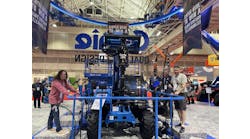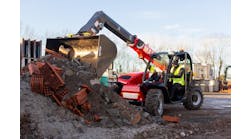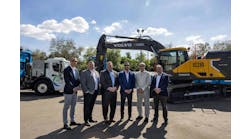Now that Terex has reached $7.6 billion in revenue — compared to less than half a billion dollars annually 10 years ago — CEO Ron DeFeo told a press conference at the Bauma Trade Fair in Munich, Germany, the company has finally reached high school.
“Terex is a very young company,” said DeFeo. “I used to say that we were a middle-school company, I think we are finally in our first year of secondary education with aspirations to go to the university and maybe have an advanced degree. But we still are very young.”
What DeFeo means is that Terex has a long way to go on the journey with huge growth opportunities ahead. But the growth opportunities to come won’t come by acquisition.
“If you examine our business carefully, since 2002 we have made only a few small acquisitions and our business has grown from a little south of $4 billion to [$7.6 billion] and to the $8.2 to $8.5 billion we expect in 2007.”
Terex has always been a company of aggressive growth and today is no different. After introducing 26 new models in its construction group alone in 2006, it is continuing to offer new products from each of its five product divisions, and had more than 80 products on display at Bauma.
DeFeo said the company’s goals for 2010 are 12 X 12 in 10. “That’s to be $12 billion in revenue, with a 12 percent operating margin in 2010,” he said. “What must we accomplish? To achieve $12 billion in revenue by 2010, we need to grow the company 12 percent each year. We’ve grown 28 percent per year [on average] for 11 years.”
Does that mean DeFeo is lowering expectations to reach $12 billion by 2010? Not at all, he says. “But as you get bigger, it’s hard to grow a lot faster. Twelve percent is still quite aggressive.
“I don’t think you’ll find another company with that level of growth. We believe we are operating at about a 10 percent operating margin today, so we need to add about two points of margin improvement. We have significant initiatives with our supply chain to do that. Today Terex buys more steel than a small car company, yet we buy it from 1,000 different suppliers. Think about the potential as we merge our supply and purchasing capabilities together.”
After making a number of major acquisitions in the late 1990s and early 2000s, Terex found itself with the need to improve internal organization and become a unified company. The Westport, Conn.-based manufacturer is confident that the company’s internal improvement will facilitate margin improvement.
Another area for growth is international expansion. Terex, with a diverse product range, has many opportunities to expand particular product areas in different continents where it hasn’t been as strong in the past.
“We’ve got an experienced leadership team, both from leaders that have grown up with the company as well as leaders that we have brought into the company,” DeFeo added. “And if there is any one issue we have, it’s the need to continue to develop our talent and have that talent be global in its thinking, to have us view Asia as a domestic market, just like we view Waverly, Iowa, as a domestic market. And if we do that and do that well, with lean initiatives, great things are still possible for us.”





